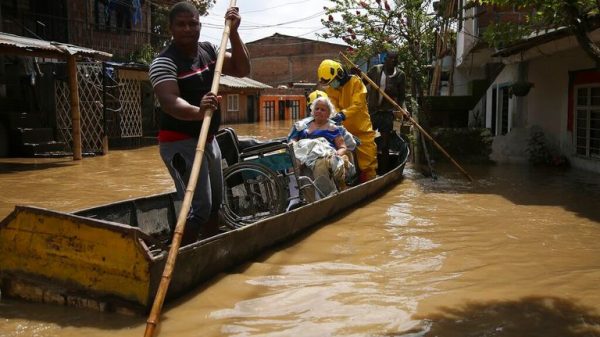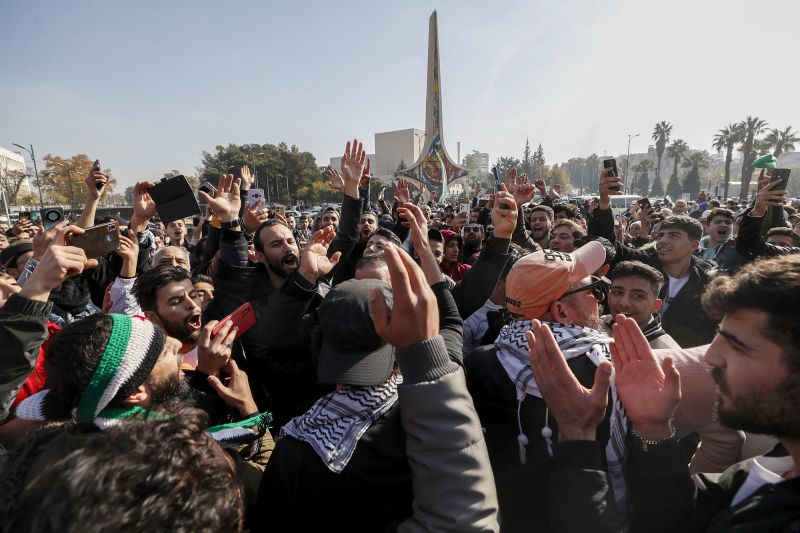At the historic Umayyad Mosque in the heart of Damascus, a red, white, black and green flag flies.
On the other side of the Syrian capital, former Syrian President Bashar al-Assad’s palace burns.
An anchor reads the Sunday news: “We announce to you from the Syrian news channel the victory of the great Syrian revolution after 13 years of patience and sacrifice.”
And on the streets, hundreds of people cheer, celebrating the stunning fall of 50 years of the Assad family’s dictatorship.
After less than two weeks of fighting across Syria’s northwest, rebel groups swiftly seized control of the capital. Their presence seemed to catch the regime off guard, forcing Assad to flee to Russia with his family.
In a speech from the Umayyad Mosque on Sunday, Abu Mohammad al-Jolani, the leader of Syria’s main rebel group, Hayat Tahrir al-Sham (HTS), called the toppling of Assad a “victory for the entire Islamic nation.”
“This is a nation that, if its rights are taken, will continue to demand them until they are restored,” Jolani said, adding that HTS was liberating people who were imprisoned by the Assad regime.
Their swift move into the capital astonished citizens and the rest of the world.
Here’s how the rebels’ ascent to power unfolded:
November 27: Rebel forces launch their first attack
Syrian rebel forces launched a large-scale attack on Assad’s forces in western Aleppo, the first sign of what was to come from their offensive and marking the first flare-up between the two sides in years.
At least 37 people were killed – both regime forces and allied militia – and rebels seized 13 villages, including the strategic towns of Urm al-Sughra and Anjara, as well as Base 46, the largest Syrian regime army base in western Aleppo, according to a statement by opposition factions at the time.
It was unclear then if the attacks meant anything more. Rebel groups said they were in response to recent artillery shelling from Assad’s regime.
But it quickly became clear that wasn’t the case. Three days later, the first city would fall.
November 30: Rebels take control of Aleppo city
On November 30, the rebel groups conducted a lightning-fast offensive, killing dozens of government soldiers and taking control of Aleppo, Syria’s second-largest city.
The Syrian army tacitly acknowledged its forces were in retreat, saying “large numbers of terrorists” had forced it to “implement a redeployment operation.” It said reinforcements were on their way and government forces were preparing for a “counteroffensive.”
December 5: Rebels take control of Hama
The rebels continued their offensive onward to the city of Hama.
Hama is strategically located at a key crossroads in western-central Syria, providing direct supply lines between Damascus and Aleppo.
The Assad regime had held Hama for more than a decade, but by Thursday the Syrian military said it had to withdraw after rebels “penetrated several parts of the city.”
“Guys, my country is being liberated. I swear to God, we are inside Hama city, we are inside Aleppo city,” a fighter cheered as he filmed himself by a local landmark in Hama.
From there, the rebels had their eyes set on Homs.
December 6: Rebels take control of Daraa, the birthplace of the 2011 uprising
The opposition forces continued their push onwards toward Damascus, seizing the city of Daraa with the assistance of rebel factions who represented the Druze sect in the neighboring city of as-Suwayda.
The army said it was “redeploying” after the attack, with rebels attacking the forces from both the north and the south.
In the southern city of Homs, hundreds of people appeared to flee on Friday night as rebel forces said they reached the city wall.
December 7: Homs falls
After moving south for days, the HTS quickly took control of Homs.
On Saturday evening, the HTS said it had “fully liberated” the major city, as Syrians tore down posters of Assad and set fire to them.
“We were able to liberate four Syrian cities within 24 hours: Daraa, Quneitra, Suwayda and Homs,” said Lt. Col. Hassan Abdul Ghani, a spokesperson for the main rebel group, ahead of their entry to Damascus.
After the regime forces left, residents flooded the streets in celebration.
December 8: Damascus – and Assad’s rule – falls to rebels
Early on Sunday morning, Syrian rebels declared the capital of Damascus “liberated” after entering the city with very little resistance from regime forces.
Russian state media soon confirmed that Assad had fled to Moscow, and Jolani addressed Syrians from the Umayyad Mosque. He said: “This victory, my brothers, is a victory for the entire Islamic nation. This new triumph, my brothers, marks a new chapter in the history of the region.”



























